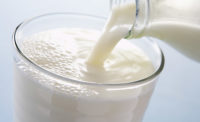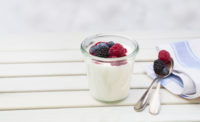Like all other food categories, the yogurt market is creating new products to attract more consumers. Although there is no definition for these “specialty yogurts,” they typically reflect trends found in many other food categories, including international styles, indulgent and botanical flavors, added protein and fiber, sugar reduction, artisanal recipes and more, according to Dairy Farmers of Wisconsin, citing Innova Market Insights.
Less sugar
U.S. yogurts have been known for having plenty of sugar, with some brands having more than 30 grams per 8-ounce serving. Within the mainstream brands, newer claims include “less sugar” and “no added sugar.” Between 2014 and 2018, there was 68.2% share growth in “low sugar” and 34.6% share growth in “no added sugar” claims, according to Innova Market Insights.
Sugar contributes texture and sweetness, so replacing it can be tricky. Most of the time, the added sugar is part of the fruit or flavor base.
Many companies use high-potency sweeteners to provide sweetness and need to use other ingredients such as hydrocolloids to provide texture in the fruit base. High-potency sweeteners such as acesulfame K and sucralose have been used for a long time in yogurt, but they are considered to be artificial sweeteners. Stevia leaf extract and monk fruit extract, on the other hand, are preferred by some consumers because they are “natural sweeteners.”
Other sweeteners to consider for “no added sugar” claims are erythritol and allulose. They provide sweetness and calories but do not contribute to added sugar.
Interesting flavors
Indulgent or dessert flavors in yogurt have been prominent for many years, but even more so as the fat content of yogurts has increased. Some yogurts even conveniently put the inclusions typically found in ice cream in a separate package to use as “mix-ins.”
More recent indulgent flavors in yogurt include s’mores, coffee, cotton candy, pumpkin spice and peanut butter. For those who love doughnuts, “donut” flavors are the theme for the Yoplait-Dunkin line of yogurts, which include Apple Fritter, Boston Crème, Cinnamon Coffee Roll and French Vanilla Latte flavors.
For consumers who are more into flowers, some of the high-protein products also feature botanical flavors such as peach hibiscus and strawberry rose. Others found in some traditional yogurts are blueberry lavender and orange blossom honey. Look for more botanicals added to yogurts in the future, as chrysanthemum and butterfly pea are the up-and-coming flavors in the botanical flavor category.
International flair
Greek, Icelandic and Australian-style yogurts have established themselves in the market across multiple brands. If you are looking for a yogurt experience from a different culture, some products that don’t have large enough market numbers yet to be counted as a category include French-, Bulgarian- and Swiss-style yogurts.
Yoplait Oui has been in the market for a few years but is a one-of-kind product with its origins based in France. It is known for its light, creamy texture and mild flavor.
Bulgaria is particularly proud of its yogurt because in 1905, the country’s own Dr. Stamen Grigorov discovered Lactobacillus delbrueckii subsp. Bulgaricus, the bacterium in yogurt that we more commonly refer to as Lactobacillus bulgaricus. Traditional Bulgarian yogurt is referred to as “sour milk” and is more sour and jelly-like than our yogurts. Balkan Treasure Yobul is yogurt made in the United States with cultures from Bulgaria and milk from Jersey cows.
Yodelay is a product that has its origins in Switzerland but is made in Wisconsin with milk from Brown Swiss cows. This clean-label product has a thinner texture and tarter flavor than most of our spoonable yogurts and some of most “true to the fruit” flavors you will find.
As our population becomes more diverse and people also travel more internationally, it should provide some opportunities to create new and exciting yogurt products.




